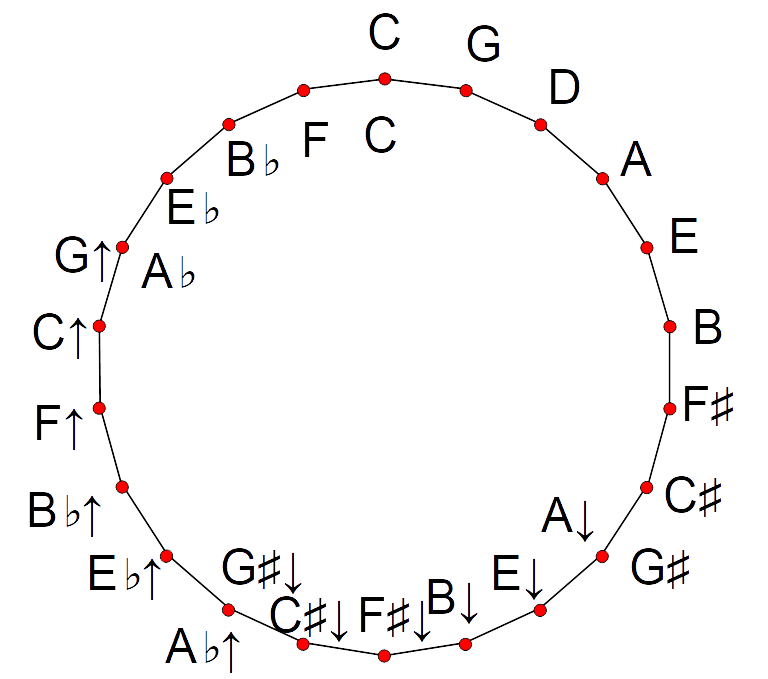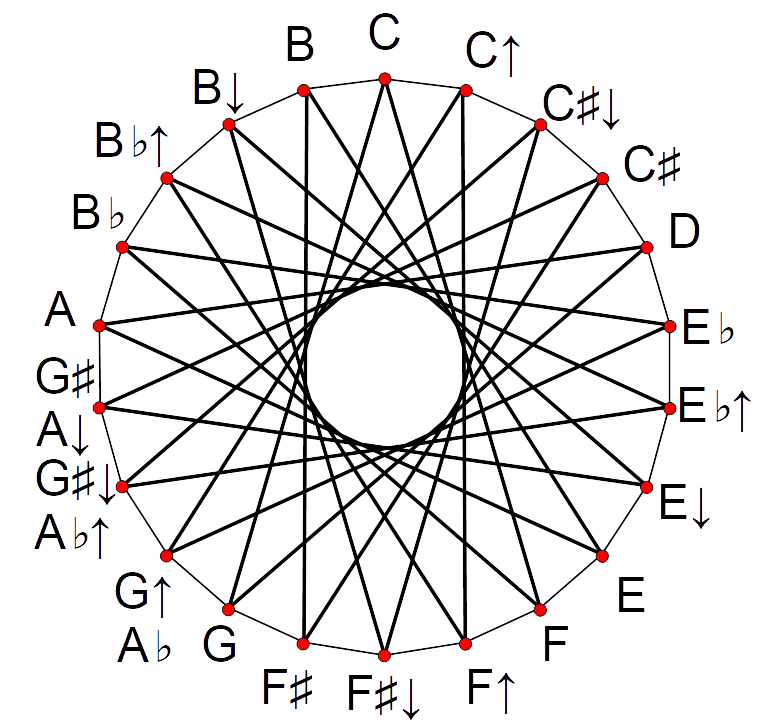22 Equal Temperament on:
[Wikipedia]
[Google]
[Amazon]
In music, 22 equal temperament, called 22-TET, 22- EDO, or 22-ET, is the tempered scale derived by dividing the octave into 22 equal steps (equal frequency ratios). Each step represents a frequency ratio of , or 54.55 cents ().
When composing with 22-ET, one needs to take into account a variety of considerations. Considering the 5-limit, there is a difference between 3 fifths and the sum of 1 fourth + 1 major third. It means that, starting from C, there are two A's - one 16 steps and one 17 steps away. There is also a difference between a major tone and a minor tone. In C major, the second note (D) will be 4 steps away. However, in A minor, where A is 6 steps below C, the fourth note (D) will be 9 steps above A, so 3 steps above C. So when switching from C major to A minor, one need to slightly change the note D. These discrepancies arise because, unlike 12-ET, 22-ET does not temper out the

 22-EDO can be notated several ways. The first, Up/Down Notation, uses ups and downs in addition to sharps and flats, chord spellings may change(C, E, G is C major triad). This yields the following chromatic scale:
C, C, C, C,
D, E, E, E, E,
F, F, F, F,
G, G/A, G/A, G/A,
A, B, B, B, B, C
The second, Quarter Tone Notation, uses quarter tone notation to divide the notes of Up/Down Notation. However, some chord spellings may change(C, E, G is C major triad). This yields the following chromatic scale:
C, C, C/D, D,
D, D, D/E, E, E,
F, F, F/G, G,
G, G, G/A, A,
A, A, A/B, B, B, C
The third, Porcupine Notation, introduces no new accidentals, but significantly changes chord spellings(C, E, G is C major triad). In addition, enharmonicities from 12-EDO are no longer valid. This yields the following chromatic scale:
C, C, D,
D, D, E,
E, E, F,
F, F, G,
G, G, G/A, A,
A, A, B,
B, B, C, C
22-EDO can be notated several ways. The first, Up/Down Notation, uses ups and downs in addition to sharps and flats, chord spellings may change(C, E, G is C major triad). This yields the following chromatic scale:
C, C, C, C,
D, E, E, E, E,
F, F, F, F,
G, G/A, G/A, G/A,
A, B, B, B, B, C
The second, Quarter Tone Notation, uses quarter tone notation to divide the notes of Up/Down Notation. However, some chord spellings may change(C, E, G is C major triad). This yields the following chromatic scale:
C, C, C/D, D,
D, D, D/E, E, E,
F, F, F/G, G,
G, G, G/A, A,
A, A, A/B, B, B, C
The third, Porcupine Notation, introduces no new accidentals, but significantly changes chord spellings(C, E, G is C major triad). In addition, enharmonicities from 12-EDO are no longer valid. This yields the following chromatic scale:
C, C, D,
D, D, E,
E, E, F,
F, F, G,
G, G, G/A, A,
A, A, B,
B, B, C, C
Erlich, Paul, "Tuning, Tonality, and Twenty-Two Tone Temperament"
''William A. Sethares''.
Pachelbel's Canon in 22edo (MIDI)
''Herman Miller'' {{Musical tuning Equal temperaments Microtonality
syntonic comma
In music theory, the syntonic comma, also known as the chromatic diesis, the Didymean comma, the Ptolemaic comma, or the diatonic comma is a small comma type interval between two musical notes, equal to the frequency ratio 81:80 (= 1.0125) ...
of 81/80, and in fact exaggerates its size by mapping it to one step.
Extending 22-ET to the 7-limit
7-limit or septimal tunings and intervals are musical instrument tunings that have a limit of seven: the largest prime factor contained in the interval ratios between pitches is seven. Thus, for example, 50:49 is a 7-limit interval, but 14 ...
, we find the septimal minor seventh (7/4) can be distinguished from the sum of a fifth (3/2) and a minor third (6/5). Also the septimal subminor third (7/6) is different from the minor third (6/5). This mapping tempers out the septimal comma
A septimal comma is a small musical interval in just intonation that contains the number seven in its prime factorization. There is more than one such interval, so the term ''septimal comma'' is ambiguous, but it most commonly refers to the in ...
of 64/63, which allows 22-ET to function as a "Superpythagorean" system where four stacked fifths are equated with the septimal major third
In music, the septimal major third , also called the supermajor third (by Hermann von Helmholtz among others Hermann L. F. von Helmholtz (2007). ''Sensations of Tone'', p. 187. .) and sometimes '' Bohlen–Pierce third'' is the musical interval ...
(9/7) rather than the usual pental third of 5/4. This system is a "mirror image" of septimal meantone
In music, septimal meantone temperament, also called ''standard septimal meantone'' or simply ''septimal meantone'', refers to the tempering of 7-limit musical intervals by a meantone temperament tuning in the range from fifths flattened by the am ...
in many ways. Instead of tempering the fifth narrow so that intervals of 5 are simple while intervals of 7 are complex, the fifth is tempered wide so that intervals of 7 are simple while intervals of 5 are complex. The enharmonic structure is also reversed: sharps are sharper than flats, similar to Pythagorean tuning, but to a greater degree.
Finally, 22-ET has a good approximation of the 11th harmonic, and is in fact the smallest equal temperament to be consistent in the 11-limit.
The net effect is that 22-ET allows (and to some extent even forces) the exploration of new musical territory, while still having excellent approximations of common practice consonances.
History and use
The idea of dividing the octave into 22 steps of equal size seems to have originated with nineteenth-century music theoristRHM Bosanquet
Robert Holford Macdowall Bosanquet (31 July 1841 – 7 August 1912) was an English scientist and music theorist, and brother of Admiral Sir Day Bosanquet, and philosopher Bernard Bosanquet (philosopher), Bernard Bosanquet.Bosanquet was the ...
. Inspired by the division of the octave into 22 unequal parts in the music theory of India, Bosanquet noted that an equal division was capable of representing 5-limit music with tolerable accuracy. In this he was followed in the twentieth century by theorist José Würschmidt, who noted it as a possible next step after 19 equal temperament
In music, 19 Tone Equal Temperament, called 19 TET, 19 EDO ("Equal Division of the Octave"), or 19 ET, is the tempered scale derived by dividing the octave into 19 equal steps (equal frequency ratios). Each step represent ...
, and J. Murray Barbour
James Murray Barbour (1897–1970) is an American acoustician, musicologist, and composer best known for his work ''Tuning and Temperament: A Historical Survey'' (1951, 2d ed. 1953). As the opening of the work describes, it is based upon his unp ...
in his survey of tuning history, ''Tuning and Temperament''.Barbour, James Murray, ''Tuning and temperament, a historical survey'', East Lansing, Michigan State College Press, 1953 1951
Events
January
* January 4 – Korean War: Third Battle of Seoul – Chinese and North Korean forces capture Seoul for the second time (having lost the Second Battle of Seoul in September 1950).
* January 9 – The Government of the United ...
Contemporary advocates of 22 equal temperament include music theorist Paul Erlich.
Notation

 22-EDO can be notated several ways. The first, Up/Down Notation, uses ups and downs in addition to sharps and flats, chord spellings may change(C, E, G is C major triad). This yields the following chromatic scale:
C, C, C, C,
D, E, E, E, E,
F, F, F, F,
G, G/A, G/A, G/A,
A, B, B, B, B, C
The second, Quarter Tone Notation, uses quarter tone notation to divide the notes of Up/Down Notation. However, some chord spellings may change(C, E, G is C major triad). This yields the following chromatic scale:
C, C, C/D, D,
D, D, D/E, E, E,
F, F, F/G, G,
G, G, G/A, A,
A, A, A/B, B, B, C
The third, Porcupine Notation, introduces no new accidentals, but significantly changes chord spellings(C, E, G is C major triad). In addition, enharmonicities from 12-EDO are no longer valid. This yields the following chromatic scale:
C, C, D,
D, D, E,
E, E, F,
F, F, G,
G, G, G/A, A,
A, A, B,
B, B, C, C
22-EDO can be notated several ways. The first, Up/Down Notation, uses ups and downs in addition to sharps and flats, chord spellings may change(C, E, G is C major triad). This yields the following chromatic scale:
C, C, C, C,
D, E, E, E, E,
F, F, F, F,
G, G/A, G/A, G/A,
A, B, B, B, B, C
The second, Quarter Tone Notation, uses quarter tone notation to divide the notes of Up/Down Notation. However, some chord spellings may change(C, E, G is C major triad). This yields the following chromatic scale:
C, C, C/D, D,
D, D, D/E, E, E,
F, F, F/G, G,
G, G, G/A, A,
A, A, A/B, B, B, C
The third, Porcupine Notation, introduces no new accidentals, but significantly changes chord spellings(C, E, G is C major triad). In addition, enharmonicities from 12-EDO are no longer valid. This yields the following chromatic scale:
C, C, D,
D, D, E,
E, E, F,
F, F, G,
G, G, G/A, A,
A, A, B,
B, B, C, C
Interval size
The table below gives the sizes of some common intervals in 22 equal temperament. An interval shown with a shaded background — such as the septimal tritone — is one that is more than 1/4 of a step (approximately 13.6 cents) out of tune, when compared to the just ratio it approximates.See also
*Musical temperament
In musical tuning, a temperament is a tuning system that slightly compromises the pure intervals of just intonation to meet other requirements. Most modern Western musical instruments are tuned in the equal temperament system. Tempering is the ...
*Equal temperament
An equal temperament is a musical temperament or tuning system, which approximates just intervals by dividing an octave (or other interval) into equal steps. This means the ratio of the frequencies of any adjacent pair of notes is the same, wh ...
References
External links
Erlich, Paul, "Tuning, Tonality, and Twenty-Two Tone Temperament"
''William A. Sethares''.
Pachelbel's Canon in 22edo (MIDI)
''Herman Miller'' {{Musical tuning Equal temperaments Microtonality